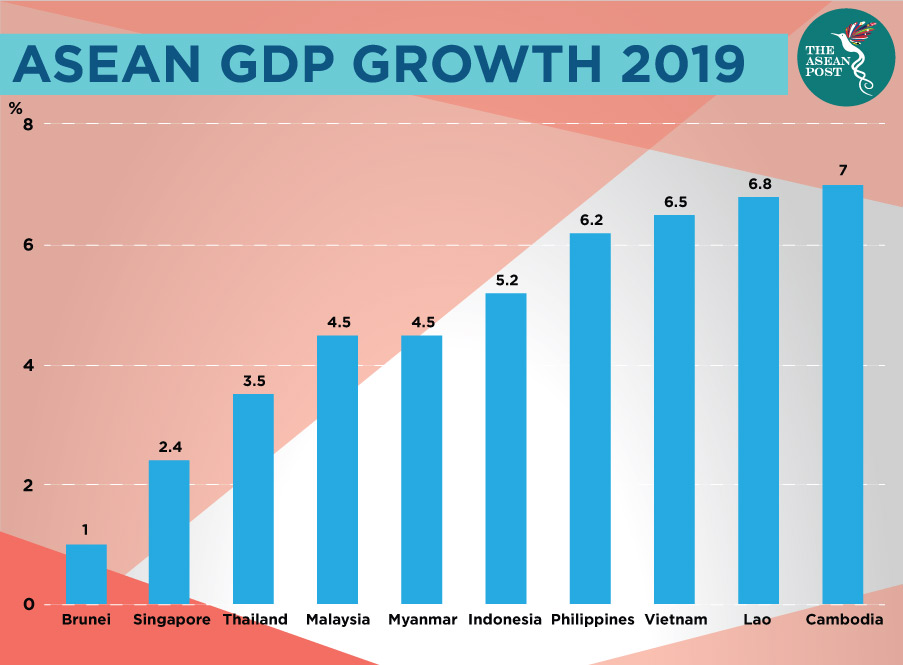While growth in Southeast Asia remains robust, data from the first half of 2019 indicates it has been slower than forecasted.
The most recent Asian Development Bank (ADB) data suggests that Southeast Asia has grown less than anticipated, resulting in slight downward revisions to growth forecasts which now stand at 4.8 percent (2019) and 4.9 percent (2020), down from 4.9 percent and 5.0 percent, respectively. Meanwhile, regional inflation for 2019 is now expected to fall to 2.4 percent from the previous forecast of 2.6 percent.
The region’s more open economies are facing the combined impacts of the United States (US)-China trade tensions and a dip in the electronics cycle, although this has partly been offset by strong domestic demand according to the ADB in last month’s supplement to its Asian Development Outlook report issued in April.
The ADB’s main economic forecasting product, the Asian Development Outlook is published each April with an update released in September and brief supplements in July and December – with Singapore, Thailand and the Philippines among the regional economies which have seen cuts in their forecasted gross domestic product (GDP) growth rates for 2019.
The outlook for the other three ASEAN countries in the report – Indonesia (5.2 percent), Malaysia (4.5 percent) and Vietnam (6.8 percent) – remain unchanged from April.

“Even as the trade conflict continues, the region is set to maintain strong but moderating growth,” said ADB Chief Economist Yasuyuki Sawada. “However, until the world's two largest economies reach (an) agreement, uncertainty will continue to weigh on the regional outlook.”
Singapore, Thailand and the Philippines
Weak manufacturing and external trade in Singapore have seen the country’s GDP forecast for 2019 dip from 2.6 percent to 2.4 percent. However, the country’s service sector has helped boost the economy, particularly information and communication – which grew by 6.6 percent year on year in the first quarter of this year. The growth in the sector comes in spite of Singtel – Southeast Asia's largest telecom operator – posting its lowest net profit in 16 years according to its annual report that was released in May.
In Thailand, the ADB forecasted the nation’s economy to grow by 3.5 percent, a drop from the original forecast of 3.9 percent. Weaker global trade caused exports to contract by 4.5 percent year-on-year in the first five months of 2019, weighing on growth. Private consumption and investment remain strong, and a sustained growth in income, low unemployment and stable prices have helped to drive private spending.
In the Philippines, the ADB cut the country’s GDP forecast from 6.4 percent to 6.2 percent largely due to the delayed passage of the national budget which held back government spending. As in other ASEAN countries, the Philippines’ growth in exports also slowed as a result of lacklustre global trade and economic activity.
However, there is widespread evidence that the redirection in trade and production has benefitted ASEAN. Vietnam, for example, expanded its exports by 6.7 percent in the first five months of this year buoyed by a 28 percent rise in exports to the US.
Best in ASEAN
Vietnam has been the fastest-growing economy in Southeast Asia this year and growth in the first half of 2019 is estimated at 6.8 percent year-on-year despite agriculture being hindered by a prolonged drought and African swine fever. Growth in industry – especially manufacturing – remained robust and foreign direct investment (FDI) rose by 27 percent in the first five months of 2019 from a year earlier.
Driven by a rapid expansion of exports such as garments and robust internal demand, Cambodia's GDP grew from 6.9 percent in 2016 to 7.0 percent in 2017 to 7.3 percent in 2018. At seven percent, the country’s forecast for 2019 during the ADB’s April report was the highest among all ASEAN member states. However, no data on Cambodia was available in July’s supplement report.
Mirroring the ADB’s confidence in the country, the World Bank and the International Monetary Fund (IMF) have also predicted that Cambodia's economy would grow by nearly seven percent in 2019.
While a drawn-out trade conflict between the US and China could severely undermine investment and destabilise growth in the region, other factors such as rising oil prices, currency depreciation and the uncertainty surrounding Brexit are also important issues surrounding economic growth in ASEAN.
Other threats to ASEAN’s progress and prosperity include climate change and the risk of natural disasters – the consequences of which affect the poor and the marginalised in developing countries disproportionally.
Although ASEAN economies have remained resilient in the face of current economic challenges, the region has to stay vigilant if it is to operate successfully in an increasingly connected trade and financial system.
Overall, strengthening domestic demand will offset weaker export growth and strong consumption –spurred by rising incomes, subdued inflation, and robust remittances – should boost economic activity in ASEAN.
Related articles:
Trump’s trade war with China enters next phase
